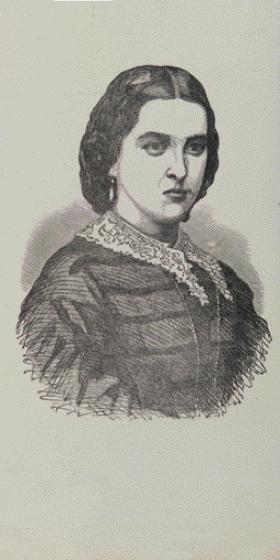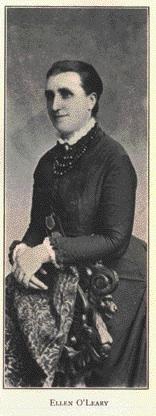‘Keepers of important secrets’: the Ladies’ Committee of the IRB
Published in 18th-19th Century Social Perspectives, 18th–19th - Century History, Features, General, Irish Republican Brotherhood / Fenians, Issue 6 (Nov/Dec 2008), Volume 16 Women provided an important part of the material support for the Fenian movement. Fenian women not only assisted in tactical efforts but also in fund-raising and prisoner support. Their most visible work was the Ladies’ Committee, established in 1865 soon after the suppression of the IRB newspaper The Irish People and the arrests of many of the IRB leadership.
Women provided an important part of the material support for the Fenian movement. Fenian women not only assisted in tactical efforts but also in fund-raising and prisoner support. Their most visible work was the Ladies’ Committee, established in 1865 soon after the suppression of the IRB newspaper The Irish People and the arrests of many of the IRB leadership.
The Committee’s primary purpose was to raise money for Fenian prisoners and their families. But Fenian women also worked covertly on behalf of the IRB. According to John Devoy, women
‘. . . were the keepers of important secrets, traveled from point to point bearing important messages, and were the chief agents in keeping the organisation alive in Ireland from the time that [James] Stephens left for America early in 1866 until the rising of 5 March 1867’.
When Stephens’s replacement, Edward Duffy, was ill, Ellen O’Leary, John O’Leary’s sister, took on ‘most of the executive work’. She also travelled to Paris on missions for Stephens, and assisted his escape from Ireland with £200 from a mortgage on her property, a considerable sacrifice on her part. Joseph Denieffe describes a Miss Butler who sheltered Stephens for the final months before his escape to France. A ‘fashionable Dublin dressmaker’ whose clientele included the Dublin élite, her business suffered greatly afterwards. Women such as Ellen O’Leary and Mary Jane O’Donovan Rossa also visited the prisoners in England and published reports in The Irishman on prison conditions and prisoner treatment.
Raising money and distributing it to the families of Fenian prisoners was the principal task of the Ladies’ Committee, or the ‘Appeal to the Women of Ireland Committee’, as it was alternatively called. The Irishman published the subscription lists each week, along with letters containing individual donations sent in care of the editor. Most of the donations were small, ranging from several pounds to mere pennies. Contributors included both women and men from Ireland, Britain, Australia and America. A substantial proportion of support came from the Irish in Britain. In addition to donations sent by sympathetic individuals or groups, the Fenian Sisterhood in America, a parallel organisation, collected funds. The Sisterhood sent $200, for example, in early 1867. The money provided food, shelter and other necessaries, paid for legal expenses, aided travel to relatives in English prisons, and assisted emigration to America and Australia. In some ways it made real the brother- and sisterhood of the Irish Republic.
Following the initial enthusiasm that greeted the October appeal, donations began to dwindle, and a new appeal, on 6 January 1866, renewed the pressure on Irishwomen to contribute. It explained that ‘for want of sufficient funds’ the Committee was unable to help all the families in need. The appeal, careful to credit those who had contributed, mostly those less well off, accusingly pointed out that ‘the rich, the well-to-do, have stood aloof’, a comparison that recurred frequently in the discourse surrounding the Committee’s efforts.
The Committee held a bazaar early in 1866 advertising ‘200 prizes’, including ‘a splendid timepiece presented by Mrs Stephens’. The success of this fund-raiser prompted the Committee to plan another, a ‘Grand National Fancy Fair and Concert in aid of the families of the State Prisoners’. But the authorities refused to grant permission, on the ground that ‘the meetings [were] intended for the purpose of assembling a number of persons engaged in treasonable practices’. Mary Jane O’Donovan Rossa explained the circumstances of the prohibition in a letter to the editor of The Irishman entitled ‘Treasonable Charity’. Making reference to an earlier episode of police harassment of the ladies’ activities, she outlined the danger of holding the event without permission:
‘We can imagine more serious results than money losses . . . A crush at the doors, a crowd at the ticket offices . . . an insulting onset of police, such as was attempted at our late concert at the Mechanics’ Institute, a resistance of the people, and a general melee, during which the emptied Richmond and Kilmainham cells would have had promise of an overflow of habitants.’

Ellen O’Leary—when James Stephens’s replacement, Edward Duffy, was ill, she took on ‘most of the executive work’ of the IRB.
Instead, the Committee held a raffle of a top prize that would have been offered at the prohibited bazaar. Despite these attempts to raise funds, donations continued to decline. On 24 March 1866 a third and last appeal appeared on The Irishman’s front page. After a detailed description of destitute prisoners’ families, and the near exhaustion of the Committee’s funds, the appeal confronted a possible reason for the marked decline in contributions—fear:
‘It has been said that your charity has been suspended with the Habeas Corpus Act. Is this true? Are your ears closed to the cries of the distressed through cowardice? Do you fear that the same authority which stopped our concerts will stay your hands when they are reached out to aid the helpless?’
The appeal produced meagre results, however. Between January and June 1866, monthly totals decreased from approximately £270 to £30. But the steady decline began to reverse direction in June. By the end of July contribution totals had risen once again to over £200. This upsurge in support coincided with an increased number of sympathetic letters and articles, as well as continued pleas from the leadership for help.
Women’s work for the Fenian movement, although under-studied, should not be undervalued. From filling in for absent or disabled leaders to raising money for destitute prisoners’ families, Fenian women played a crucial and necessary role. They also gained valuable experience that would be useful in subsequent nationalist organisations, such as the Ladies’ Land League, of which Ellen O’Leary was a treasurer. The Ladies’ Committee of the IRB provided the type of material support that would be called upon again decades later by the Ladies’ Land League and the women of Sinn Féin.
Rose Novak is a Ph.D student in English at the University of Connecticut, Storrs.
Further reading:
J. Denieffe, A personal narrative of the Irish Revolutionary Brotherhood (New York, 1906).
J. Devoy, Recollections of an Irish rebel (New York, 1929).
M.J. O’Donovan Rossa, Irish lyrical poems (New York, 1868).
E. O’Leary, Lays of country, home and friends (Dublin, 1890).
















